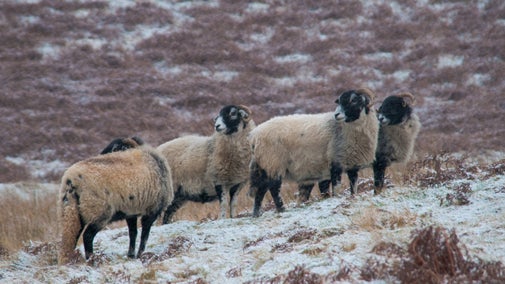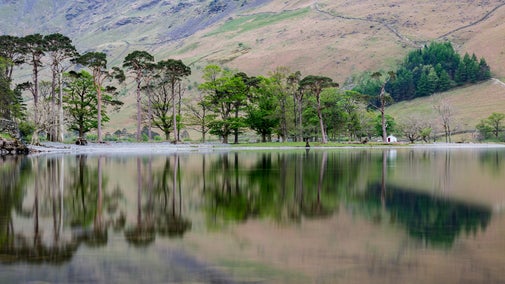
Discover more at Buttermere Valley
Find out how to get to Buttermere Valley, where to park, the things to see and do and more.

Discover the history of Buttermere from its earliest settlement to the characters who have lived in this rugged landscape surrounding the lakes. Learn about its Norse origins and notable residents such as the Maid of Buttermere, whose famous beauty and was mentioned by Wordsworth.
Neolithic or Bronze Age settlement in the valley can be traced through the rock art at Mill Beck, Buttermere and Crummock Water.
There are also a number of prehistoric summit cairns, including those at Carling Knott and Grasmoor, and it is thought that an Iron Age hillfort stood at Loweswater
The Buttermere Valley has been the site of human settlements for centuries. We know that large numbers of Vikings settled in Cumbria during the 9th and 10th centuries and many names in the area have a Norse origin. For example, we call a stream a 'beck' which comes from the Old Norse word 'bekkr'.
Did Buttermere once belong to an 11th-century Norse chieftain named Buthar? And, if so, did the lake originally get its name from being ‘Buthar’s mere’?
It is more likely that the name Buttermere derives from Old English and means ‘the lake by the dairy pastures’. The fertile nature of the lush valley sitting between the two lakes quite literally made it a suitable place to make butter.
Sheep farming, as it has been for centuries, is the principal occupation in Buttermere and it is an important grazing place for the hardy Herdwick breed.
Other industries here included some limited mining, thanks to the discovery of haematite in the west side of the valley, and some iron production in medieval times. The remains of iron smelting furnace sites, or bloomeries, can be found around just east of Buttermere.
One of the most famous historic residents of Buttermere was Mary Robinson (1778–1837). The daughter of the landlord of the Fish Inn in the village, Mary was known as the Maid of Buttermere and she was the subject of Melvyn Bragg's 1987 novel of the same name.
Mary had little knowledge of the world beyond the valley, meeting only those who grew up in the village or who happened to pass through the doors of her father’s inn.
In 1792 Captain Joseph Budworth ‘discovered’ 15-year-old Mary at the inn during one of his frequent walks across the Lake District, researching material for the articles and guidebooks he was writing.
He was so amazed by her beauty that he included her as a tourist attraction for the valley in his article to a London newspaper. He expanded on this in his guidebook A Fortnight’s Ramble to the Lakes. Budworth described her in rapturous terms with ‘a fine oval face, with full eyes and lips as sweet as vermillion’ and he even compared her to an angel.

Mary became famous overnight, with many people coming to Buttermere just to see her. William Wordsworth, wrote about her in The Prelude. Budworth himself returned after six years and lectured her to not let the fame go to her head.
In the autumn of 1802, Mary was swept off her feet by Alexander Augustus Hope, who claimed to be the brother of Lord Hopetoun. He was travelling through the Lake District and decided to see her acclaimed beauty for himself. After a whirlwind romance, the two were married in the church at Lorton on 2 October.
Just a few days after the wedding, Mary's husband was summoned to Keswick for non-payment of bills. Once in the town he was accused of stealing Alexander Hope’s identity, forging cheques and of being a thief and a liar.
Hope talked himself out of trouble and left the town. Instead of returning to his new wife, he disappeared. Constables were dispatched to find him and in December he was arrested in North Wales under his real identity, James Hatfield. He was brought back to the Lake District and imprisoned. He was later hanged at Carlisle jail for forgery and Mary was devastated to hear that her beloved husband was a liar and that he already had a wife and child.
Mary had a child by Hatfield, who sadly died of pneumonia at just three weeks old. She married again and moved to Caldbeck in the north of Cumbria, where she lived out the rest of her days as the wife of a local farmer. Her gravestone is in the churchyard there.
The white cross on the side of Fleetwith Pike overlooks Buttermere and marks the sad story of Fanny Mercer. There have been various accounts written on her fate, each one with different quirks and details, have a look for yourself and see which ones you believe! Here is a version from Professor Angus J L Winchester's "The Language of the Landscape". Fanny was a young servant girl who worked for Mr Bowden Smith, a schoolteacher from Rugby. She accompanied his family on their summer vacation in the Lakes.
One day in September 1887, the party were walking to the top of the crag above Honister Quarries and were descending the steep ridge of Fleetwith Pike. Fanny was not an accomplished walker and was holding her alpenstock incorrectly which caused her to catch the end in her stomach and loose her balance. She fell and her body came to rest 130 feet down the fell.
By the time her party reached her, she was gravely injured and taken to the nearby Gatesgarth Farm. Although she was treated by a visiting missionary who was skilled in surgery, Fanny sadly died before further medical assistance could arrive. Her body was returned to Rugby where she was buried, and the white cross was erected in her memory in Buttermere.
To this day the white cross stands as a warning to walkers that the mountains of the Lake District can be perilous unless you take care and are mindful of the dangers.
Nicholas Size had grand ideas for Buttermere. He owned the Victoria Hotel in the centre of the village, known today as the Bridge Hotel. He dreamed of transforming this quiet valley into something that could rival the Alpine ski resorts. He envisioned a chair lift to the top of High Crag and planned on constructing a large beer garden behind the hotel complete with an oompah band. He wanted to develop the services for the growing numbers of motorists passing through, a revolutionary idea for the time.
These plans never came into being, although he did create a few tea gardens. His greatest accomplishment was a nine-hole golf course in the fields leading down to Crummock.
Despite never quite achieving his plans, ‘Auld Nick’ was a much-loved character of Buttermere. He championed the idea that people were free to experience the countryside, which caused controversy with many local landowners. He enjoyed the company of others and spent many days chatting to visitors in his hotel.
His name lives on in his book The Secret Valley, which is inspired by Buttermere and tells the story of how the Normans attempted to conquer the inhabitants but were repelled by the fierce local spirit.
Nicholas was buried in his own plot of land on the rocky fellside above the Bridge Hotel, at the head of the Fairy Glen. Unfortunately, his funeral was marred by dreadful wet weather, which meant his coffin had to be lowered into the water-filled grave with stones placed on top to hold it down.
The epitaph, which he wrote himself reads:

In their 1799 walking tour, both William Wordsworth and Samuel Taylor Coleridge visited Buttermere. In his Notebooks, Coleridge wrote lyrically of a striking yew tree. This was the same tree later celebrated by Wordsworth in his poem Yew-Trees. Although damaged and reduced by a storm, the yew tree still stands on the bank of the Whit Beck, behind the Village Hall.
J. M. W. Turner’s visit to the valley was transformative for him as an artist and his spectacular Buttermere Lake, with Part of Cromackwater, Cumberland, a Shower was shown in an exhibition at the Royal Academy.
The story of conservation around Buttermere is a fascinating one. In 1814, with the encouragement and involvement of Wordsworth, John Marshall, the Leeds industrialist, bought extensive landholdings around the lakes of Buttermere, Crummock Water and Loweswater, with the aim of maintaining the beauty of the area.
Large parts of the valley have subsequently been purchased by the National Trust and the whole of the valley head of Buttermere is covered by a restrictive covenant agreed with G. M. Trevelyan in 1937. Canon Rawnsley also managed to lead a successful protest to prevent the building of a railway from Keswick to Buttermere to serve the Honister slate quarry.
Rannerdale, which means ‘the sheiling at the pass of the raven’ in old Norse, was once the site of a settlement that shows continuous habitation from the stone age up to medieval times, when it was abandoned. Two other settlements in the valley were abandoned at the same time, one at Scales, near Scale Force, and one at Peele Place.
Rannerdale is also the location of a fabled battle. It’s said that local settlers and Norsemen resisted invasion from the Normans and lured them into the valley, slaughtering them all. Between the months of April and May, the valley is covered in bluebells and local legend has it that this is because of the blood spilt there during the battle all those years before.

Find out how to get to Buttermere Valley, where to park, the things to see and do and more.
Explore the Lake District's Buttermere Valley and discover walks through rugged landscapes, panoramic views, thundering waterfalls and other forces of nature.

Discover the wildlife you can spot in the Buttermere Valley. Learn how otters have returned and how rangers care for swathes of bluebells to protect them for future generations.

From conservation projects and protecting archaeological features to improving the experience of visitors or laying hedgerows, our work at this special place is rich and varied.

Find out how to get boating and fishing permits for the lakes of Buttermere, Crummock and Loweswater before your visit.

Learn about people from the past, discover remarkable works of art and brush up on your knowledge of architecture and gardens.

From landscape gardeners to LGBTQ+ campaigners and suffragettes to famous writers, many people have had their impact on the places we care for. Discover their stories and the lasting legacies they’ve left behind.
